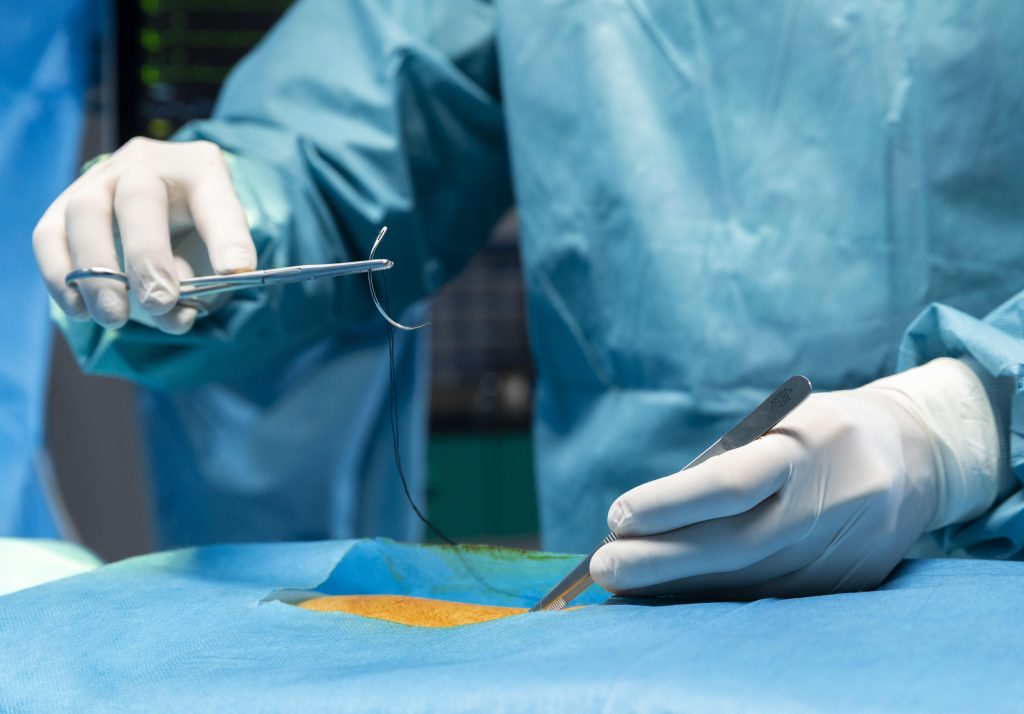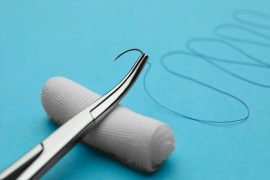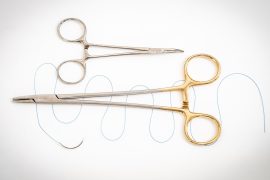Suture and Needle choices vary depending on the type of surgery and the patient’s needs. Therefore, knowing the differences between these different types of sutures and when to use them is important to get the best outcome from your surgical procedure. Using the wrong type of suture can lead to undesired surgical outcomes, damage to surrounding tissue or organs, and chronic pain. This can lead to undesired wound healing and complications during recovery, which may require re- suturing for proper wound healing. Suture usage vary on the type of Tissue, patient age as well as the Type of surgical procedure in which suturing needs to be performed. Suturing promotes wound healing by approximating the layers of the tissue and enabling the natural healing process. It also closes the wound thus avoiding the wound to get contaminated by the atmosphere.
What is a suture?
A suture is a surgical device used to close any surgical or traumatic wound requiring skin & tissue closure. A closure is intended to primarily repair skin and deeper layers of the tissue and fascia to fast-track wound healing. Some examples of sutures include monofilament sutures, monofilament polyester sutures, and large absorbable sutures. They are used for repairing cuts and wounds that are deep and open. Sutures are used to close wounds by first suturing the edges together and then using the suture to tie off the wound. After the wound has healed, the suture is either removed or absorbed naturally into the body.
Types of Sutures
Historically, similar to modern sutures, different forms of wound closure mechanisms were employed with needles made of bone and suture materials running from flax, bark, silk, human hair, reeds, etc. Today, there are many options for sutures. Hence, it becomes crucial to make the right suture choice, which means understanding the purpose, attributes, and features of each type of suture. It also means understanding the difference in filament types and the different needle types and under which clinical procedures they have been designed for use. The correct suture helps the surgeon with the right technique and choice of incision to execute and handle the surgical procedure, provide the correct strength, and secure the knots in a manner that can handle and tolerate wound changes during the healing process.
Suture material types are classified as follows:
Absorbable and Non-absorbable Sutures
Absorbable sutures, which get absorbed by the body naturally, are typically employed for deep temporary closure for tissues to heal, and the sutures lose most of their tensile strength over a period of time ranging from weeks to months. Non-absorbable sutures do not get absorbed by the body and hence are required to be removed after a few days of the surgery or may be left in the body permanently. These sutures are used for long-term tissue closures, wounds that take time to heal, like in the case of hernia fascia defects closure.
Natural and Synthetic Sutures
Sutures are further classified into natural and synthetic sutures. Natural sutures are derived from natural substances. For example Catgut Sutures are usually derived from collagen derived from bovine Guts (used for internal lacerations or wounds). Another Examples of Natural sutures are silk sutures (used in general soft tissue closure and ophthalmic surgery). Catgut degrades by enzymatic reactions (breaking down of proteins partially as peptides or completely as amino acids). They can cause inflammation at the suture site. Synthetic sutures are derived from artificial sources and are made from materials like Nylon sutures (used for general closures and plastic surgery) which is non-absorbable in nature. Synthetic absorbable sutures like Polydioxanone (PDS) sutures (used in abdominal closures or pediatric cardiac procedures) degrade by hydrolysis (the polymer structure of the filaments gets broken down with water penetrating the suture strands) which causes less inflammation at the surgical site.
Monofilament or Multifilament
Based on the structure, sutures are classified as Monofilament or Multifilament sutures.
Monofilament sutures are single filament sutures with less surface area and higher memory. By memory, we mean the tendency and capacity of a suture to return to its original shape, which makes a suture significantly prone to the knots loosening. They require greater handling and care in the form of more knots to ensure security and less fracture. Monofilament sutures have the capacity to pass through tissues easily, causing less inflammation.
Whereas Multifilament sutures, as the name suggests, are braided or twisted sutures that are easier to handle by the surgeon as they hold the knots with greater security and less memory. They are prone to inflammation and infection. Multifilament sutures are more expensive than traditional sutures.
The following are the most commonly used sutures in Surgeries:
Monofilament sutures, made of a single synthetic strand, are typically used in skin
Closures and Ligation of blood vessels.
Polypropylene sutures are the synthetic non absorbable sutures; these are typically used in soft tissue closures and are less likely to cause allergic reactions.
Dressings sutures are used to close wounds and stop bleeding. They are typically made of silk, Nylon, or synthetic materials.
Epithelial sutures are used to close and repair minor wounds. They are made of proteins and are typically used with tissue types such as skin, mucous membranes, and cartilage.
Soft Tissue sutures are used to close wounds in soft tissue such as muscle and tendons. They are also used to support joints and may be made of polyester or polypropylene.
Some sutures are specially used to repair veins and arteries. They are made of polypropylene, Polyester & Nylon.
Needle Types
The needle is indeed the next most important aspect of sutures after identifying the correct suture type. Needle quality and the appropriate needle choice for a given surgery go a long way to determining the success of the surgery. The surgical needle is mainly built from stainless steel, making it corrosion-resistant. In surgical parlance, the needle has three main parts – the Swage point, the body, and the point. The Swage point is where the surgical suture attaches to the needle by stringing through. The body connects the eye to the point and decides the shape of the needle. In most cases, the needle is curved, but in some cases, it is straight. Curved needles come in different circle lengths like ¼, ½, ⅓, or ⅜ of a circle. The nature of the wound or tissue helps a surgeon choose the needle curve length. The surgeon needs to know where the needle tip is at all times, as it aids in skin closures with minimum trauma. A wrong surgical needle type can lead to tissue injury. The ideal needle is one that is flexible enough to bend yet rigid enough to withstand distortion. It should be sharp to pierce through tough tissues yet thin to cause minimum trauma. Stability of the needle to ensure accurate placement is also equally required. Thus, an appropriate surgical needle must be sterile, corrosion-resistant, and firm enough to prevent any bending or distortion, prevent tissue trauma and injury, and ensure easy penetration.
Different types of needles are based on the tip, like taper needles or cutting ones. Cutting needles have a tip with three sharp edges. In a typical conventional cutting needle, the cutting surface is inside the needle. In contrast, a reverse cutting needle used most commonly for sewing skin has it on the outside. Whereas taper needles are round and can be either blunt or sharp and are recommended for soft and delicate tissues and tendon repair. They typically pierce the skin without cutting it and spread the tissue as it passes through.
Summary
The right type of suture will prevent issues with excessive bleeding, damage to surrounding tissue or organs, and chronic pain. The thickness of the tissue, the location of the tissue, the risk of infection, and the amount of tension, along with different anesthesia requirements and patient age, play an important role in determining which type of suture to use. There needs to be more than the right type of suture to yield the desired surgical results. The correct choice of needle is equally essential and needed for a wound to be sutured with accuracy, precision, and minimal trauma, ensuring fast healing and preventing tissue reaction and inflammation.
FAQs :
Why is it important to use the correct suture technique?
It is important to use the correct suture technique for precision, minimal trauma to the wound at the surgical site and for faster healing.
Why is knowledge of suture material so important?
The knowledge of the right suture material is very important to the surgeon to maximize tissue healing and ensure scar aesthetics and minimal tissue trauma and inflammation at the surgical site.
What factors influence the surgeon’s choice of suture materials?
The main factors that influence a surgeon’s choice of suture materials are
- Healing time of the wound or tissue
- Wound type and strength
- Properties of the suture material
- Faster attachment of suture and tissue





Comments are closed.